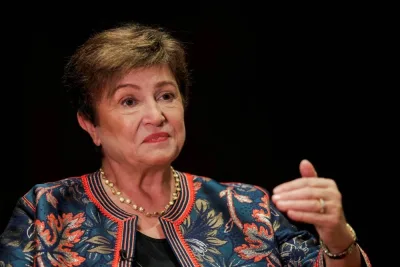A familiar word in economics is inflation, which has plunged many countries into long periods of instability.
Central bankers often aspire to be known as “inflation hawks” who believe that monetary policies should maintain high-interest rates to curb inflation.
Long-lasting phases of high inflation are often the result of lax monetary policy. If the money supply grows too big relative to the size of an economy, the unit value of the currency diminishes; in other words, its purchasing power falls and prices rise.
While presenting its semi-annual World Economic Outlook, the International Monetary Fund (IMF) said central banks should prepare to tighten policy in case inflation gets out of control.
The Washington, DC-based IMF, however, expects high inflation to recede in most advanced economies by the middle of next year. But it warns there is tremendous uncertainty around the outlook for both economic growth and inflation due to supply chain disruptions that have convulsed the global economy and pushed up consumer prices around the world.
IMF downgraded the fund’s global growth forecast for the year and emphasised the need for a more equitable distribution of Covid-19 vaccines from wealthy countries to developing and middle-income countries.
Recently, the IMF cut its global growth forecast for 2021 to 5.9% from 6% in its July report, a result of a reduction in its projection for advanced economies to 5.2% from 5.6%. The reduction mostly reflected problems with a global supply chain that caused a mismatch between supply and demand.
For emerging markets and developing economies, the outlook improved. Growth in these economies is pegged at 6.4% for 2021, up from an estimate of 6.3% in July. The uptick reflected stronger performances by some commodity-exporting countries amid rising energy prices.
The group maintained its view that the global growth will moderate to 4.9% in 2022.
A key theme of the IMF’s report was the “dangerous divergence” between advanced economies and the rest of the world. The IMF expects output in advanced economies to return to pre-pandemic forecasts by next year, and exceed them by 2024.
By contrast, emerging markets and developing economies, excluding China, are expected to remain 5.5% below the pre-pandemic forecast in 2024.
The biggest driver of this divergence is the “great vaccine divide.” The IMF estimates that over 60% of people in high-income countries are fully vaccinated. In low-income countries, by contrast, around 96% of the population remains unvaccinated.
The warning was part of the IMF’s quarterly update on global economic conditions. The fund slightly downgraded the outlook for global growth this year, but slashed the US GDP forecast by a full percentage point from its July outlook, albeit to a still robust 6% that is ahead of the 5.2% forecast for all developed economies.
Central banks including Fed (US Federal Reserve) believe that the primary weapon to fight inflation is hiking interest rates. The central bank in the United States has not raised rates since 2018.
Undoubtedly, pressures on the supply or demand side of the economy can be inflationary.
Therefore, supply chain issues need to be addressed on a war footing to avoid price spikes from becoming a major threat to global economic recovery.



